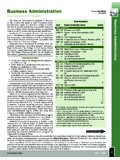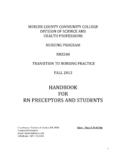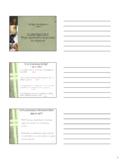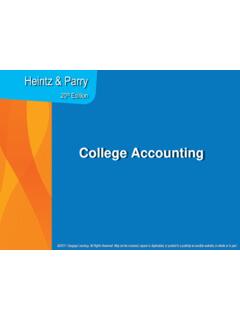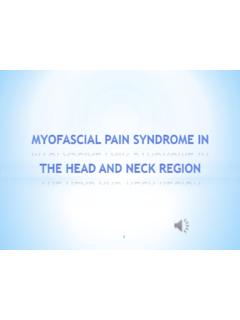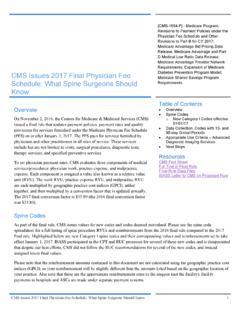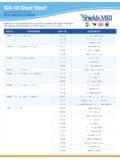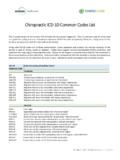Transcription of Structure and Function of the Vertebral Column
1 Structure and Functionof the Vertebral ColumnSpine 33 Vertebral segments divided into 5 segments Cervical: 7 vertebrae Thoracic: 12 vertebrae Lumbar: 5 vertebrae Sacral: 5 vertebrae, fused in the adult Coccygeal: 4 vertebrae, also fused in adultSpinal Column ViewsNormal Curvature of Spine Lordosis: set in a curve that has its convexity anteriorly and concavity posteriorly Kyphosis: set in a curve that has its concavity anteriorly and convexity posteriorly Purpose To absorb ground reaction forces To transmit load of upper body throughout lower bodyWhich segments are lordoticand which are kyphotic?What does this do to the lordosisin the lumbar spine?How would you describe this woman s thoracic spine?Normal line of gravity lateral viewOther methods of assessing posture Anterior view Posterior view For both, looking for symmetry of bony landmarks from both sides Postural AssessmentIdeal Posture There is no normal posture. Ideal posture serves as a reference point.
2 Ideal Distributes gravitational stress for balanced muscle Function . Allows joints to move in their mid range to minimize stress on ligaments and articular of Poor Posture on Muscles Overstressed muscles tighten. Favored muscles weaken. This imbalance perpetuates the poor postural dysfunctionsParts of a VertebraBodyVertebral ForamenPedicleLaminaTransverse ProcessArticular FacetSpinous ProcesssuperiorinferiorbodyspVertebralfo ramenNeural ArchParts of a vertebrae Body Vertebral foramen Pedicles Transverse process Lamina Spinous process Articular facet Superior InferiorIntervertebral Discs Function Absorbing and transmitting forces Components Annulus Fibrosus 10-20 concentric fibrocartilaginous rings Encases nucleus Nucleus Pulposus Gelatinous center 70-90% water Shock absorberTerminology Individual vertebrae are numbered by region and in a cranial-sacral directionTerminology Discs are described by their position between two vertebrae Spinal nerves are described in the same way as the vertebraeOsteology of the SpineCervical Vertebrae Smallest and most mobile C3-7 are similar in osteology.
3 C1 and C2 are unique C3-C7 Transverse processes possess holes called transverse foramen (allows Vertebral artery to travel through it) Most spinous processes are bifid (two-pronged) Allows for attachment for muscles bilaterallyC-1 Vertebrae Called Atlas Has no body, it is ring-like, and consists of an anterior and a posterior arch and two lateral masses Articulates with skull s occipital condyles Atlanto-occipital jointC-2 Vertebrae Called Axis Allows rotation of C-spine Atlas sits directly on top of axis Articulates with inferior facet of atlas to form Cervical Vertebrae C3-C7 Cervical Vertebrae Recap C1 is called atlas C1 and skull form atlanto-occipital joint C2 is called axis Vertical process called dens Axis-atlas forms atlanto-axial joint (accounts for half of all rotation that occurs at neck) Unique features of C3-C7 Transverse foramen Bifid spinous processesThoracic Vertebrae 12 vertebrae 12 rib Body and transverse processes have costal facets Unique features Inferiorly projected long spinous processes Posterior/lateral transverse processes More round Vertebral foramenLumbar Vertebrae Bigger Vertebral bodies than others, why?
4 Other aspects of vertebrae are stouter and broader than other areas Contain small mammillary and accessory processes on their bodiesExamples of VertebraeIntervertebral foramenSacrum and Coccyx Sacrum 5 vertebrae fused together into a triangular shaped bone Do have foramen for nerves to exit which will innervate the lower extremity Coccyx Tailbone (4 fused vertebrae) Together form sacrococcygeal jointSupporting Structures of Vertebral Column Joints Atlanto-occipital joint Condyloid joint; allows flex/extension and lateral rotation Atlanto-axial joint Allows rotation only; pivot joint Intervertebral joints (C2-S1) Three ways Facet joints-plane joint (allows flex/ext, lat flex, and rotation) Lamina are connected via a ligament (ligamentum flavum) Bodies are connected via the disc (not a synovial joint) FibrocartilaginousFacet Joints, aka apophyseal jointsSupporting Structures of Vertebral Column Ligaments Ligamentum flavum runs between lamina of adjacent vertebrae and limits excessive flexion Anterior longitudinal ligament Attaches the anterior aspect of the Vertebral body Posterior longitudinal ligament Attaches to the posterior aspect of the Vertebral bodyAnt and Post Longitudinal LigamentKinematics Movement in the spinal Column is defined by the direction of motion of the anteriorside of the vertebrae Can be confusing because the spinous process (posterior) and the anterior side move in opposite directions.
5 Kinematics All segments of Vertebral Column permits: Flexion/extension Lateral flexion to the Right and Left Rotation to the Right and Left Motions are graded on the summation of the entire Vertebral segment, not each individual vertebraeKinematics Craniocervical (neck): most mobile of all segments Thoracolumbar Thoracic spine allows flex/ext, and the majority of lat flex and rotation Lumbar spine allows for the majority of flex/extension Position of Pelvis affects Position of Lumbar Spine The pelvis can be rotated anteriorly and posteriorlyCommon Pathologies:ScoliosisCommon Pathologies:Disc Disc tear, bulge, herniation, prolapse, and dessication Like a wet sponge, a healthy disc is flexible. A dry sponge is hard, stiff, and can crack easily. Due to the position of spinal nerves exiting through the transverse foramen, disc problems can have a negative affect on those nervesMyology of the Vertebral ColumnInnervations Dorsal Ramus Innervates most muscles of posterior neck and truck Ventral Ramus Most muscles of ant-lateral trunk and neckAnterior NeckSternocleidomastoidOriginSternal head: superior aspect of the manubrium of the sternumClavicular head: medial 1/3 of the clavicleInsertionMastoid process of the temporal boneInnervationSpinal accessory n.
6 (cranial n. XI)ActionUnilateral:Contralateral rotation of the head and neck;Ipsilateral lateral flexion of the head/neck Bilateral:flexes the head/neckAnterior NeckScalenesOriginAnt. Scalene: transverse processes of C3-C7 Middle Scalene: transverse processes of C2-C7 Posterior Scalene: transverse processes of C5-C7 InsertionAnt. Scalene: 1stribMiddle Scalene: 1stribPosterior Scalene: external surface of the 2ndribInnervationVentral rami (C3-C7)ActionBilateral:flexion of the neck, assist with inspiration by elevating ribs 1&2 Unilateral:lateral flexionCOPD Overuse of respiratory accessory musclesPosterior NeckSplenius CapitisOriginMastoid process and lateral superior nuchal lineInsertionLigamentum nuchae and spinous processes C7-T3 InnervationDorsal rami C2-C8 ActionBilateral:extensionUnilateral: Ipsilateral lateral flexion and rotation of head and neckPosterior NeckSplenius CervicisOriginTransverse process of C1-C3 InsertionSpinous process of T3-T6 InnervationDorsal rami C2-C8 ActionBilateral:extension of neckUnilateral.
7 Ipsilateral lateral flexion and rotation of head and neckClass one Lever relating to neck pain In good posture, resistance arm is short and muscles can act on it easily The further the neck is forward (bad posture of cerivcal or thoracic spine), the resistance arm is lengthenedAnterior-Lateral TrunkRectus AbdominisOriginCrest of the pubisInsertionXiphoid process and cartilages of ribs 5-7 InnervationIntercostal n. (T7-T12)ActionFlexion of the trunk, posterior pelvic tiltAnterior-Lateral TrunkExternal ObliqueOriginLateral side of ribs 4-12 InsertionIliac crest and linea albaInnervationIntercostal nerves (T8-T12)ActionBilateral: Flexion of the trunk, posterior pelvic tilt, Unilateral: contralateral Rotation of the trunk; Ipsilateral lateral flexion of the trunkAnterior-Lateral TrunkInternal ObliqueOriginIliac crest, inguinal ligament & thoracolumbar fasciaInsertionRibs 9-12, linea albaInnervationIntercostal n. (T8-T12)ActionBilateral: flexion of the trunk, posterior pelvic tilt, increases intra-abdominal and intra-thoracic pressureUnilateral: lateral flexion of the trunk, rotation of the trunk to the ipsilateral sideAnterior-Lateral TrunkTransverse AbdominisOriginIliac crest, thoracolumbar fascia cartlages of ribs 6-12, & inguinal ligamentInsertionLinea albaInnervationIntercostal n.
8 (T7-T12)ActionIncreases intra-abdominal pressure, increases tension in thoracolumbarfasciaIncreasing Intra-Abdominal pressureand thoracolumbar fasica By increasing tension and pressure, we stabilize the lumbar spin Via thoracolumbar fascia, we have a rigid Column of muscles from anterior-posteriorWithout even looking at their back, who has the stronger back?Back StabilizersIliopsoasOriginPsoas Major: transverse processes of T12-L5 Iliacus: Iliac fossaInsertionLesser trochanter of the femurInnervationFemoral n. ActionHip flexion, trunk flexion, anterior pelvic tiltBack stabilizersQuadratus LumborumOriginCrest of the iliumInsertionTransverse processes of L1-L4 & 12thribInnervationVentral rami (T12-L3)ActionBilateral: extension of the lumbar regionUnilateral: lateral flexion of the trunkErector SpinaeLarge vertically oriented muscles on both sides of the spinous processes (about one hand s width laterally) Extend and stabilize the entire Vertebral Column and craniocervical regionPosterior TrunkIliocostalisInferior AttachmentLumborum: common tendonThoracis: angle of ribs 6-12 Cervicis: angle of ribs 3-7 Superior AttachmentLumborum: angle of ribs 6-12 Thoracis: angle of ribs 1-6 Cervicis: transverse processes of C4-C6 InnervationDorsal rami of adjacent spinal n.
9 ActionBilateral:extensionUnilateral: lateral flexionPosterior TrunkLongissimusInferior AttachmentThoracis: common tendonCervicis: transverse processes of T1-T4 Capitis: Transverse processes of T1-T5 & near facet joints C3-C7 SuperiorAttachmentThoracis: transverse processes of T1-T12 Cervicis: Transverse processes of C2-C6 Capitis: mastoid process of temporal boneInnervationDorsal rami of adjacent spinal : extensionUnilateral: lateral flexionPosterior TrunkSpinalisInferior AttachmentThoracis: common tendonCervicis: ligamentum nuchae and spinous processes C7-T1 Capitis: Blends with semispinalis capitisSuperiorAttachmentThoracis: Spinous processes of T1-T6 Cervicis: Pinous process of C2 Capitis: Blends with semispinalis capitisInnervationDorsal rami of adjacent spinal : extensio
